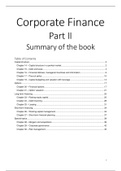2021
Summary Health
Promotion and Disease
Prevention
MASTER HEALTH SCIENCES
LOES KIEVITSBOSCH
,Inhoudsopgave
Introduction lecture ......................................................................................................................................... 6
Key points ........................................................................................................................................................... 6
Types of prevention ............................................................................................................................................ 6
Lifestyle factors .................................................................................................................................................. 7
Lecture 2 – Hearing Problems ........................................................................................................................... 8
Key points ........................................................................................................................................................... 8
Facts ................................................................................................................................................................... 8
Causal factors for hearing impairments ............................................................................................................. 9
Consequences of hearing impairment ................................................................................................................ 9
Take home messages ....................................................................................................................................... 11
Reasons for low use and satisfaction of hearing aids....................................................................................... 12
Technical & practical ................................................................................................................................... 12
Psychosocial................................................................................................................................................. 12
Take home message .................................................................................................................................... 13
Conclusion Predictors of entering a hearing aid evaluation period: a prospective study in older hearing-help
seekers .............................................................................................................................................................. 13
Lecture 3 – Upstream determinants of lifestyle behaviours and chronic disease risk ..................................... 15
Key points ......................................................................................................................................................... 16
What are upstream determinants .................................................................................................................... 17
Social environment ........................................................................................................................................... 18
Obesogenic environments ................................................................................................................................ 18
Challenges in upstream research ..................................................................................................................... 19
1. Acknowledging complexity ................................................................................................................ 19
2. Understanding the system ................................................................................................................. 19
3. Changing (parts of) the system/implementing an intervention within a system .............................. 20
4. Evaluating impact ............................................................................................................................... 20
Upstream research needs: ................................................................................................................................ 20
What’s next? .................................................................................................................................................... 21
Article The upstream determinants of adult obesity ........................................................................................ 21
Conclusion ................................................................................................................................................... 22
Lecture 4 – Community action: a transdisciplinary approach to health promotion ......................................... 24
Key points ......................................................................................................................................................... 25
Community approach ....................................................................................................................................... 27
Why community approach? ........................................................................................................................ 27
Aim of community action research ............................................................................................................. 28
Transdisciplinary research ................................................................................................................................ 28
Case ............................................................................................................................................................. 29
Background ...................................................................................................................................................... 30
Community ....................................................................................................................................................... 31
Community participation .................................................................................................................................. 31
1
, Methods for action research ....................................................................................................................... 32
Social network approach .................................................................................................................................. 32
Intersectoral collaboration .......................................................................................................................... 33
Challenges in community action....................................................................................................................... 33
Document The community approach to health education intervention .......................................................... 33
Community approach .................................................................................................................................. 34
Ecological levels ........................................................................................................................................... 35
Working or community organisation principles .......................................................................................... 36
Community project organisation ................................................................................................................. 38
Summary and discussion ............................................................................................................................. 39
Lecture 5 – Quality of life ............................................................................................................................... 41
Key points ......................................................................................................................................................... 42
Learning objectives ........................................................................................................................................... 44
Quality of Life (QoL) .......................................................................................................................................... 45
Fundaments ................................................................................................................................................. 45
Related concepts/terms .............................................................................................................................. 46
QoL outcomes .............................................................................................................................................. 46
Facts ............................................................................................................................................................. 46
Why should we measure QoL? .................................................................................................................... 47
How to measure QoL? ................................................................................................................................. 47
Examples ...................................................................................................................................................... 47
Types of QoL questionnaires/measures ............................................................................................................ 48
1. Generic ............................................................................................................................................... 48
2. Disease-specific .................................................................................................................................. 48
Main advantages of using valid, reliable and responsive QoL questionnaire(s) ......................................... 49
Choosing an instrument – checklist .................................................................................................................. 49
Barriers for using QoL questionnaires ......................................................................................................... 49
Article What is quality of life? .......................................................................................................................... 50
Core components of multidimensional HRQoL assessment ........................................................................ 50
Ways HRQoL can improve patient care ....................................................................................................... 50
Examples of well-regarded HRQoL instruments .......................................................................................... 51
Barriers to using PROs in a research setting or clinical setting .................................................................... 51
Conclusions .................................................................................................................................................. 51
Lecture 6 – Green spaces and health .............................................................................................................. 52
Key points ......................................................................................................................................................... 53
Learning objectives ........................................................................................................................................... 54
Green space and health .................................................................................................................................... 54
Do people with green space in their environment feel healthier? ............................................................. 54
Mechanism behind the relation between green space and health .................................................................. 55
1. Reducing stress-levels ........................................................................................................................ 55
2. Increasing social contacts .................................................................................................................. 56
3. Increasing physical activity................................................................................................................. 56
4. Improved development of children ................................................................................................... 56
5. Improves micro climate ..................................................................................................................... 56
6. Healthier food/diet ............................................................................................................................ 57
Interventions green spaces ............................................................................................................................... 57
Article Nature and health ................................................................................................................................. 57
Pathways through which contact with nature relates to health ................................................................. 58
2
, 1. Air quality ........................................................................................................................................... 58
2. Physical activity .................................................................................................................................. 58
3. Social cohesion ........................................................................................................................................ 58
4. Stress reduction ................................................................................................................................. 58
Conclusion ........................................................................................................................................................ 59
Lecture 6 – Evaluation .................................................................................................................................... 60
Key points ......................................................................................................................................................... 61
Learning objectives ........................................................................................................................................... 65
Evaluation......................................................................................................................................................... 65
What is evaluation ....................................................................................................................................... 65
Why evaluate? ............................................................................................................................................. 65
An evaluation plan includes......................................................................................................................... 65
2 types of evaluation ................................................................................................................................... 66
RE-AIM Framework .......................................................................................................................................... 68
R – Reach ..................................................................................................................................................... 68
E – Effectiveness .......................................................................................................................................... 68
A – Adoption ................................................................................................................................................ 68
I – Implementation ...................................................................................................................................... 69
M – Maintenance ........................................................................................................................................ 69
GRADE .............................................................................................................................................................. 69
Factors that lower the quality of evidence .................................................................................................. 69
Article Evaluating the impact of health promotion programs: using the RE-AIM framework to form summary
measures for decision making involving complex issues .................................................................................. 70
Summary ...................................................................................................................................................... 70
Chapter Develop an evaluation program ......................................................................................................... 71
Key messages ............................................................................................................................................... 71
1. Research integrity .............................................................................................................................. 72
2. Observed change ............................................................................................................................... 72
3. Internal validity .................................................................................................................................. 72
4. Effect explanation .............................................................................................................................. 72
5. Cost-benefit........................................................................................................................................ 73
1. Applicability........................................................................................................................................ 73
2. Generalisability .................................................................................................................................. 73
Designs......................................................................................................................................................... 73
Threats to internal validity .......................................................................................................................... 74
Alternative designs ...................................................................................................................................... 76
Conclusion ................................................................................................................................................... 78
Lecture 8 – Economic evaluations .................................................................................................................. 80
Key points ......................................................................................................................................................... 81
Economic evaluations ....................................................................................................................................... 83
Types of economic evaluations ......................................................................................................................... 84
1. Cost-effectiveness analysis ................................................................................................................ 84
2. Cost-utility analysis ............................................................................................................................ 84
3. Cost-benefit analysis .......................................................................................................................... 84
4. Cost-minimization analysis................................................................................................................. 84
Steps of an economic evaluation ...................................................................................................................... 84
1. Identification of the perspective ........................................................................................................ 85
2. Identification of the alternatives ....................................................................................................... 85
3. Identification, measurement and valuation of effects ...................................................................... 85
3











